Information about the town of Ruse - Bulgaria
Ruse PropertiesThe town of Ruse has 162 128 inhabitants and is on 50 metres above sea level. It is located on the high right bank of the Danube River, 496 m from the outflow of the big river. It is 320 km north-east of Sofia, 203 km north-west of Varna, 106 km north-east of Veliko Turnovo, 146 km north-east of Pleven, 97 km north-east of Svishtov, 122 km south-west of Silistra, 66 km north-west of Razgrad. The greatest and the most important Bulgarian town on the Danube River, known also as ?Little Vienna? because of its ancient architecture. It is a regional administrative centre.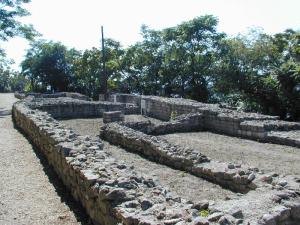
The famous Ruse mound - a prehistoric settlement, existing for more than 5000 years, is located within the boundaries of the modern town. At the beginning of the new era on a part of the territory of the modern town of Ruse an ancient settlement of Sexaginta Prista (The sixty ships) emerged, where ?prista? means a particular type of a Greek river guard vessel. Probably it was founded by the Roman Emperor Vespasian (69-79). Later on it was known under the names of Pristis and Pristapolis. It existed up to the 6th century, when the Avars brought it to ruins. In Medieval times a new settlement emerged near the ruins of the ancient settlement, and information about it was found for the first time in the Broush Guidebook of the 16th century under the name of Rossi. In the Sultan Register of 1431 and in a Peace Treaty concluded between the Ottoman Empire and the Magyar state dated 20th of August 1503 the settlement was mentioned under the name of Roussi. In Ahmed Neshri chronicles as well as in many other old maps the town was shown as a wholesome town together with the settlement of Giurgiu on the opposite side of the Danube River named Yorgogi, Yorgovo, Yuroukova, Roussi on both sides of the Danube River, Giurgiu on both sides of the Danube River.
In 1595 the Wallachian ruler Mihai Vityazoul (the Courageous) made an attempt to liberate Bulgaria with an Wallah-Bulgarian army and the town was brought to ruins. After its reconstruction at the beginning of the 17th century it was given the name of Rouschouk (little Roussi). The town turned into an important port and a strong border fortress. In 1811 the Russian General Koutouzov carried out the famous Rouschouk battle and became known as a talented military commander. In 1864 the town became the centre of the Danube District of the Ottoman Empire. In 1866 the building of the first railway road in Bulgarian lands - Rouschouk-Varna was completed. The first modern agricultural farm was founded under the name of Noumine (Exemplary farm). The River Management was founded as well and in a short period of time 7 steam ships and 15 barges were purchased. A printing house was opened with printing machines from Vienna where newspapers, books and textbooks were printed. The bookshop of Hristo G. Danov was opened at that time. To meet the needs of the secular education in Rouschouk in 1843 Alexander Ruset published in Strasbourg the first geographical map in Bulgarain.
European influence penetrated into the town through the active river transport along the Danube River (predominantly Austro-Hungarian ships) and this had positive impact on the development of the town. Architecture developed, too and the construction of private and public buildings resembling the style of the capital of the Austro-Hungarian Empire Vienna commenced. The European fashion in clothing also penetrated first in this Bulgarian town.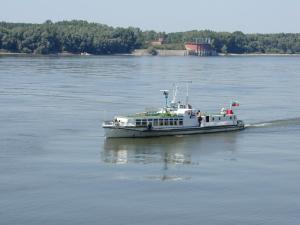
On the 1st January 1866, the first in Bulgaria, meteorological observations began here with modern Austrian equipment.
Rouschouk was not left aside from the struggle for spiritual and national liberation either, moreover that in its capacity of being a gate to Europe it was here that the modern freedom-loving ideas of the Old Continent made their way into the country. Zora (Dawn) Chitalishte (reading room and community centre) and the home of the extraordinary Bulgarian woman patriot baba (grandmother) Tonka Obretenova became centres of the national struggle. A lot of revolutionaries were assisted to leave the Empire or to return to their Fatherland. It was here that Angel Kunchev - one of the most faithful and ardent followers of Vassil Levski died here during an exchange of fire with the Turkish police. Baba Tonka, her sons and daughters, revolutionaries who gave their lives for the freedom of Bulgaria - Stefan Karadzha, Angel Kunchev, Zahari Stoyanov, Lyuben Karavelov, Panayot Hitov, Hristo Makedonski, Dimitur Tsenovich and a lot of other great Bulgarians were buried in this town.
A Pantheon-Charnel House of the national Revival heroes with an everlasting fire was opened in Ruse in 1979. The bones of many of the 453 dignified Bulgarians, who were born in or who linked their lives with this town and whose names are inscribed in the Pantheon were collected in it. On 20th February 1878 the Russian Army led by General Totleben entered Rouschouk and was enthusiastically welcomed by the population led by Archbishop Kliment Branitski (Vassil Droumev).
The town was the biggest in the liberated Bulgarian lands over 20 000 inhabitants. On 31st July 1879 the Bulgarian flag of the ships donated by Russia was risen which marked the beginning of the organised Bulgarian river navigation. The first marine technical school, later on moved to Varna, was opened here in 1881. The same year was found the first Bulgarian bank Girdap. In 1889 the first Bulgarian Chamber of Commerce, and two years later the first joint-stock insurance company ?Bulgaria - were established in Ruse. As of the end of the 19th century a lot of celebrated architects did their creative work in the liberated of Ruse (Edward Winter, Udo Ribau, Georg Lang, Edwin Petritski, Negos Bedrossyan, Todor Tonev, Nikola Lazarov and others), painter-decorators (Karlo Francescani, Giovanni Pitor and others), landscapers (Ferdinand Halober, Rihard Noyvirt and others). It is not due to randomness that Ruse is being considered the most European Bulgarian town even nowadays. The writers Elias Kaneti, awarded the Nobel Prize for literature for 1981, Dobri Nemirov, Michael Arlan were born here, Lyuben Karavelov, Ivan Vazov, Stoyan Mihailovski, the poet Tsvetan Radoslavov, author of the text of the Bulgarian national anthem, the painter Joul Pasken (Pinkas), the pianist Otto Liebih, the opera singer Mimi Balkanska, Academician Mihail Arnaoudov lived here.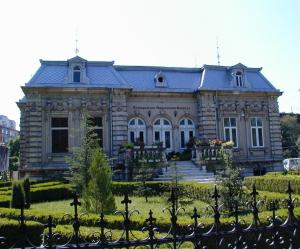
The role of the town grew up even more with the construction of the so-called Bridge of Friendship between the Bulgarian and the Rumanian banks in 1954. It was here that at the end of the 1980-ies the civil movement for protection of the town from the pollution of the Giurgiu Chemical Works (Rumania) originated and it marked the beginning of the democratic changes in Bulgaria. Nowadays Ruse is a big economic, transport, cultural and tourist centre.
About 200 buildings in Ruse are considered part of architectural historical heritage of Bulgaria, 12 of which are especially valuable. In the first place this is the Dohodnoto Zdanie (The Profitable Building) with the winged Mercury on its roof (the Old Theatre), built in 1902 by the architects Raul Brank, Georg Lang and Frank Scholts, which together with the Monument to Freedom (1908), a remarkable work of the architect and sculptor from Florence Arnoldo Zocci, are the symbols of Ruse. The following are also among the most outstanding cultural and historical monuments: The High School of Music; the Catholic Church with coloured stained-glass; the buildings of the Savings Bank, the Chamber of Commerce and Industry (Lyuben Karavelov Library), the boys? high school ?Knyaz Boris? (now a secondary vocational school ?Hristo Botev?); The house of the sailor; the Regional Administration (granted for a museum); The Club of the Culture Functionaries; The Duty-Free Zone Administration; the Simeonovs Brothers? House. The native home of Elias Kaneti is located at 13, Gurko Street.
The ancient sites of interest of the town also include Leventabia Fortress (a restaurant complex now), the Kyuntukapiya Gate from Mitiriza, the Mahmoud Column, the Holy Trinity Church (8, Holy Trinity Square) dating back to the beginning of the 17th century, the Fleet Tower, built in 1884 by architect Franz Gruenanger for meteorological observations. There are monuments to those killed in the Serbian-Bulgarian War of 1885, to Russophilles, to Baba Tonka, to Lyuben Karavelov, Stefan Karadzha, Raycho Nikolov, etc.
There is a higher educational institution, too the University of Ruse.
The Riga Hotel Square. The Danube Hotel. The Splendid Hotel. The Yordan Petrov Hotel. The Dom na Armiyata. The Rai (Paradise) Motel. The Prista Chalet. Lyulyaka Camping.
Bus, railway and river transport services the inter-town and international connections of the town. There are regular bus lines to Sofia, Varna, Pleven, Veliko Turnovo, Shoumen, Razgrad, Turgovishte and a lot of other towns and villages of the country. Ruse is the initial (or the final) station of two railway lines Ruse - Gorna Oryahovitsa Stara Zagora Podkova and Ruse - Kaspichan - Varna. It is connected through them to the national railway network.
The river station of Ruse is a big one. Since 1992 the river passenger transport along the Bulgarian Danubian riverside have been discontinued but their continuance is solely a matter of time. There are cruises only along the international route Ruse - Belgrade - Novo Sad - Budapest - Bratislava - Vienna - Linz - Pasau with Bulgarian and mainly foreign tourists. Tourist?s tour cruises on little ships are organised during the summer. Since 1993 the ferryboat line Ruse - Giurgiu has been in operation, too. There is town bus and trolley bus transport in Ruse.
Prista Western Park is located at the distance of 6 km from Ruse along the road to the town of Byala. There are beautiful deciduous forests, well shaped lanes, tourist can visit the the Danubian island of Lyulyaka, Prista Chalet, Lyulyaka Camping, the Danube Motel, Ribarska Koliba (Fisherman?s hut) - interesting restaurant. There are town bus lines _ No. 6 and No. 16 running to the park. Another big site for recreation, sports, touri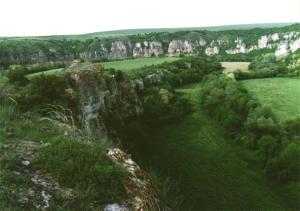 sm, sunbathing and all other kinds of entertainment is situated at the distance of 12 km east of Ruse _ the Lipnik Forest Park. There are country houses, restaurants, artificial lakes, a hotel, a zoo corner, a sports base and a camping site. There is a town bus line functioning in this direction.
sm, sunbathing and all other kinds of entertainment is situated at the distance of 12 km east of Ruse _ the Lipnik Forest Park. There are country houses, restaurants, artificial lakes, a hotel, a zoo corner, a sports base and a camping site. There is a town bus line functioning in this direction.
Obraztsov Chiflik (Exemplary Farm) is situated at the distance of 3 to 4 km from the Lipnik Forest Park and possesses beautiful deciduous forests, fertile land and vineyards (an example of the economic development in the past) and two little sprightly tourist chalets Zdravets Chalet and Minzuhar Chalet. There is a regular bus line (Ruse - Obrzatsov Chiflik) and one can walk to the Minzuhar Chalet in 30 minutes from the last stop and another 30 minutes to the Zdravets Chalet along a marked track.
The Rusenski Lom River Valley, along with its tributaries Beli (White), Malki (Little) and Cherni (Black) Lom represents a unique world in itself in which the amazing nature is entwined into out remote past history. Part of the valley with the territory of 3260 hectares was proclaimed a Natural Park (at the distance of 20 km south of Ruse). The rivers have created incredibly beautiful gorges into the limestone rock foundation. It is genuine joy for the eyes and real paradise for rock climbers.
One of the most significant military, economic and cultural centres of Bulgaria during the 13th and the 14th centuries was located there_ the Medieval Town of Cherven (on the right bank of the Cherni Lom River, by the name of the same village, at the distance of 31 km south of Ruse). Out of the preserved ruins most interesting are the parts of the fortified walls, the defensive tower (used as a model for the restoration of the Baldwin Tower on Tsarevets Hill in Veliko Turnovo), the two gates, the castle, the foundations of a great number of churches, the foundations of the boyar palaces, the two unique in their kind water pumping facilities with vaulted staircases, etc. There is a regularly functioning bus transport to the village.
Many monks-hermits settled down in the valley during the late Middle Ages. Whole monastery complexes were created there - Ivanovski, Maluk Rai (Little Paradise), Golyam Rai (Great Paradise), Koshouta (Doe) and churches with exquisite mural paintings, a part of which was preserved. The mural paintings of the Ivanovski Rock Churches (on the Rusenski Lom River) are one of the summits of Medieval Bulgarian Art (work of masters from the Turnovo School of Painting). In 1983 they were entered into the cultural list of UNESCO protected sites. There is a regularly functioning bus transport to the village of Ivanovo.
The Alpinist Chalet is situated on the bank of the Rusenski Lom River, at the distance of 6 km south of the 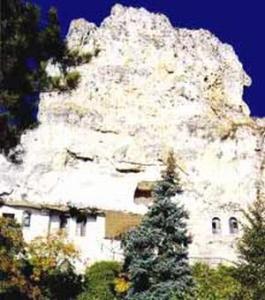 Prista Chalet (14 beds on plank-beds and 6 bungalows with 36 beds in 2-, 3- and 4-bed rooms, reservations at Prista Tourist Association, Ruse) with perfect possibilities for rock climbing along routes with different categories of difficulty. It is located at the distance of 1 km south-east along an asphalt road from the village of Bassarbovo. There is regular bus transport to the village.
Prista Chalet (14 beds on plank-beds and 6 bungalows with 36 beds in 2-, 3- and 4-bed rooms, reservations at Prista Tourist Association, Ruse) with perfect possibilities for rock climbing along routes with different categories of difficulty. It is located at the distance of 1 km south-east along an asphalt road from the village of Bassarbovo. There is regular bus transport to the village.
The Bassarbovo Monastery is situated at the distance of 2 km from the chalet. The village of Pissanets with the Mamoulya rock phenomenon and the strongly fortified Pissansko gradishte (ruins of an ancient town) are situated at the distance of about 25 km south of Ruse, on the banks of the Beli Lom River. There is regular bus transport to that site.
The Danube River provides great opportunities for recreation, water sports, water tourism, fishing and lots of entertainment. There are wonderful little places, like the islands of Lyulyaka and Mateya, the riverside at Stulpishte, Marten and so on. The shelters for accommodation are not few in number, there are attractive public catering establishments, sports bases, tourist chalets, beaches and all of them are accessible either by car or by public transport.
Ruse Properties

